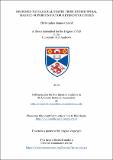Files in this item
Designed topological states from hybrid spiral magnet-superconductor heterostructures
Item metadata
| dc.contributor.advisor | Braunecker, Bernd | |
| dc.contributor.author | Carroll, Christopher James | |
| dc.coverage.spatial | 107 p. | en_US |
| dc.date.accessioned | 2019-04-10T16:12:10Z | |
| dc.date.available | 2019-04-10T16:12:10Z | |
| dc.date.issued | 2019-06-24 | |
| dc.identifier.uri | https://hdl.handle.net/10023/17497 | |
| dc.description.abstract | In this thesis a Green’s function based, analytical formalism is developed to describe dense chains of spiral ordered classical magnetic moments embedded in superconducting substrates. I demonstrate that an understanding of the dimensional mismatch between the substrate and impurity chain is crucial to understand the physics at play. Renormalised gap closures are discovered by exact, analytic solution for a ferromagnetic chain and insights gleaned are used to understand the spiral ordered case to which it can be smoothly tuned. I investigate the topological characteristics of this model and find an ambiguity in defining effective Hamiltonians due to the dimensional embedding of the chain in the substrate. To aid in resolving this ambiguity I develop formalism which allows one to write down Green’s functions for bounded, semi infinite systems in terms of more easily attainable, exact solutions for infinite systems. I derive simple expressions to identify the presence of topological bound states which agrees with purely one dimensional models and changes suggestively when applied to the aforementioned two dimensional model. I then work to extend the formalism to allow the exact solution of two or three parallel chains, taking into account all possible interactions with the classical magnetic impurities. The solutions are decoupled so that they can be written in terms of the 𝑇 matrices for a single chain, with additional levels of resummation. I find that the induced sub-gap spectrum for the two chain solution completely replaces those from each individual chain, leading to oscillating, helix like band structures. I use the complicated solution of the three chain solution to inform a potential ansatz to solve the 𝑁 chain case. | en |
| dc.description.sponsorship | "This work was supported by the EPSRC under grant number EP/M506631/1." -- Funding | en |
| dc.language.iso | en | en_US |
| dc.publisher | University of St Andrews | |
| dc.rights | Attribution-NonCommercial-NoDerivatives 4.0 International | * |
| dc.rights.uri | http://creativecommons.org/licenses/by-nc-nd/4.0/ | * |
| dc.subject | Superconductivity | en |
| dc.subject | Magnetism | en |
| dc.subject | Green's function | en |
| dc.subject | Analytic solution | en |
| dc.subject | T matrix | en |
| dc.subject | Majorana fermion | en |
| dc.subject | Yu-Shiba-Rusinov states | en |
| dc.subject | Topological superconductivity | en |
| dc.subject | Self consistent numerics | en |
| dc.subject.lcc | QC611.97M34C2 | |
| dc.subject.lcsh | Superconductivity | en |
| dc.subject.lcsh | Magnetism | en |
| dc.subject.lcsh | Green's functions | en |
| dc.title | Designed topological states from hybrid spiral magnet-superconductor heterostructures | en_US |
| dc.type | Thesis | en_US |
| dc.contributor.sponsor | Engineering and Physical Sciences Research Council (EPSRC) | en_US |
| dc.type.qualificationlevel | Doctoral | en_US |
| dc.type.qualificationname | PhD Doctor of Philosophy | en_US |
| dc.publisher.institution | The University of St Andrews | en_US |
| dc.identifier.doi | https://doi.org/10.17630/10023-17497 | |
| dc.identifier.grantnumber | EP/M506631/1 |
The following licence files are associated with this item:
This item appears in the following Collection(s)
Except where otherwise noted within the work, this item's licence for re-use is described as Attribution-NonCommercial-NoDerivatives 4.0 International
Items in the St Andrews Research Repository are protected by copyright, with all rights reserved, unless otherwise indicated.


